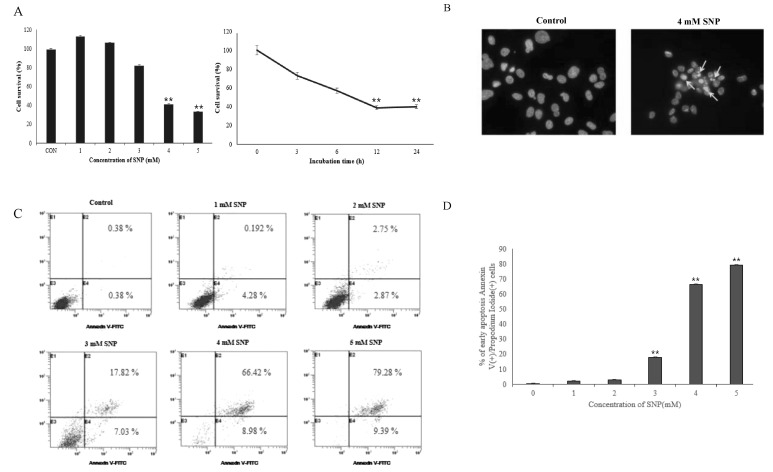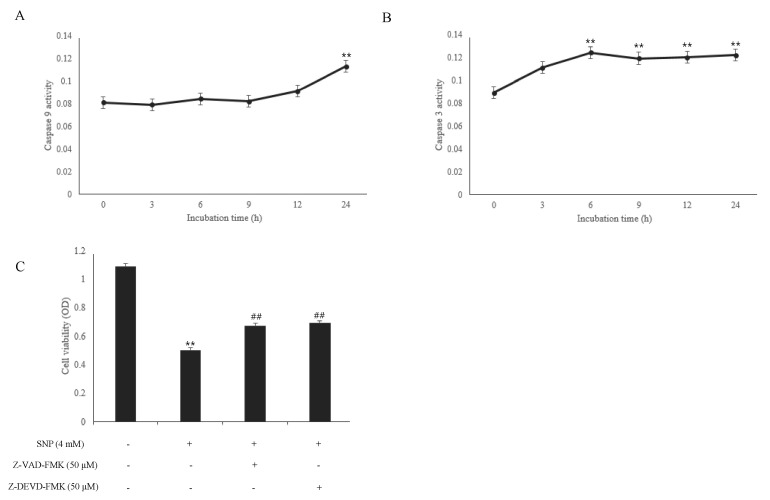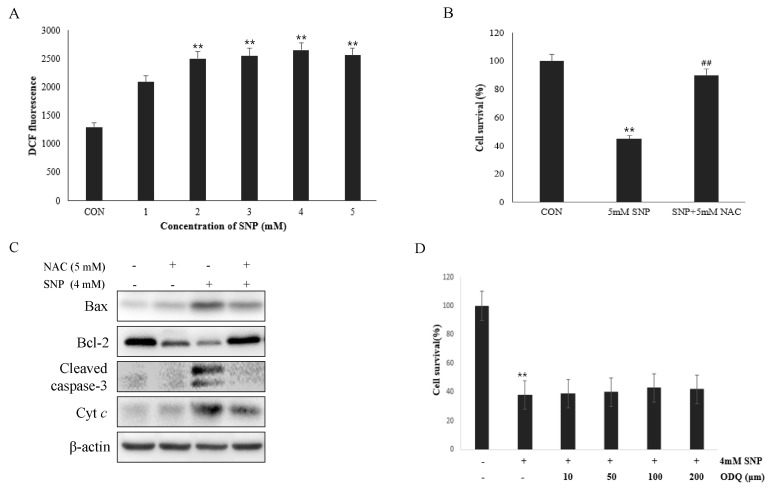Korean J Physiol Pharmacol.
2014 Feb;18(1):25-32. 10.4196/kjpp.2014.18.1.25.
Nitric Oxide-Induced Apoptosis of Human Dental Pulp Cells Is Mediated by the Mitochondria-Dependent Pathway
- Affiliations
-
- 1Dental Science Research Institute and Medical Research Center for Biomineralization Disorders, Department of Oral Physiology, School of Dentistry, Chonnam National University, Gwangju 500-757, Korea. jjy@jnu.ac.kr, wjkim@jnu.ac.kr
- 2Dental Science Research Institute and Medical Research Center for Biomineralization Disorders, Department of Oral Anatomy, School of Dentistry, Chonnam National University, Gwangju 500-757, Korea.
- 3Dental Science Research Institute and Medical Research Center for Biomineralization Disorders, Department of Periodontology, School of Dentistry, Chonnam National University, Gwangju 500-757, Korea.
- KMID: 2285487
- DOI: http://doi.org/10.4196/kjpp.2014.18.1.25
Abstract
- Nitric oxide (NO) is recognized as a mediator and regulator of inflammatory responses. NO is produced by nitric oxide synthase (NOS), and NOS is abundantly expressed in the human dental pulp cells (HDPCs). NO produced by NOS can be cytotoxic at higher concentrations to HDPCs. However, the mechanism by which this cytotoxic pathway is activated in cells exposed to NO is not known. The purpose of this study was to elucidate the NO-induced cytotoxic mechanism in HDPCs. Sodium nitroprusside (SNP), a NO donor, reduced the viability of HDPCs in a dose- and time-dependent manner. We investigated the in vitro effects of nitric oxide on apoptosis of cultured HDPCs. Cells showed typical apoptotic morphology after exposure to SNP. Besides, the number of Annexin V positive cells was increased among the SNP-treated HDPCs. SNP enhanced the production of reactive oxygen species (ROS), and N-acetylcysteine (NAC) ameliorated the decrement of cell viability induced by SNP. However, a soluble guanylate cyclase inhibitor (ODQ) did not inhibited the decrement of cell viability induced by SNP. SNP increased cytochrome c release from the mitochondria to the cytosol and the ratio of Bax/Bcl-2 expression levels. Moreover, SNP-treated HDPCs elevated activities of caspase-3 and caspase-9. While pretreatment with inhibitors of caspase (z-VAD-fmk, z-DEVD-fmk) reversed the NO-induced apoptosis of HDPCs. From these results, it can be suggested that NO induces apoptosis of HDPCs through the mitochondria-dependent pathway mediated by ROS and Bcl-2 family, but not by the cyclic GMP pathway.
Keyword
MeSH Terms
-
Acetylcysteine
Annexin A5
Apoptosis*
Caspase 3
Caspase 9
Cell Survival
Cyclic GMP
Cytochromes c
Cytosol
Dental Pulp*
Guanylate Cyclase
Humans*
Mitochondria
Nitric Oxide
Nitric Oxide Synthase
Nitroprusside
Reactive Oxygen Species
Tissue Donors
Acetylcysteine
Annexin A5
Caspase 3
Caspase 9
Cyclic GMP
Cytochromes c
Guanylate Cyclase
Nitric Oxide
Nitric Oxide Synthase
Nitroprusside
Reactive Oxygen Species
Figure
Cited by 1 articles
-
Effects of Local Pancreatic Renin-Angiotensin System on the Microcirculation of Rat with Severe Acute Pancreatitis
Zhijian Pan, Ling Feng, Haocheng Long, Hui Wang, Jiarui Feng, Feixiang Chen
Korean J Physiol Pharmacol. 2015;19(4):299-307. doi: 10.4196/kjpp.2015.19.4.299.
Reference
-
1. Massey WL, Romberg DM, Hunter N, Hume WR. The association of carious dentin microflora with tissue changes in human pulpitis. Oral Microbiol Immunol. 1993; 8:30–35. PMID: 8510981.
Article2. Ohnishi T, Daikuhara Y. Hepatocyte growth factor/scatter factor in development, inflammation and carcinogenesis: its expression and role in oral tissues. Arch Oral Biol. 2003; 48:797–804. PMID: 14596869.
Article3. Carr AC, McCall MR, Frei B. Oxidation of LDL by myeloperoxidase and reactive nitrogen species: reaction pathways and antioxidant protection. Arterioscler Thromb Vasc Biol. 2000; 20:1716–1723. PMID: 10894808.5. Förstermann U, Closs EI, Pollock JS, Nakane M, Schwarz P, Gath I, Kleinert H. Nitric oxide synthase isozymes. Characterization, purification, molecular cloning, and functions. Hypertension. 1994; 23:1121–1131. PMID: 7515853.
Article6. Korhonen R, Lahti A, Kankaanranta H, Moilanen E. Nitric oxide production and signaling in inflammation. Curr Drug Targets Inflamm Allergy. 2005; 4:471–479. PMID: 16101524.
Article7. Boissel JP, Schwarz PM, Förstermann U. Neuronal-type NO synthase: transcript diversity and expressional regulation. Nitric Oxide. 1998; 2:337–349. PMID: 10100489.
Article8. Shaul PW. Regulation of endothelial nitric oxide synthase: location, location, location. Annu Rev Physiol. 2002; 64:749–774. PMID: 11826287.
Article9. Shin W, Cuong TD, Lee JH, Min B, Jeon BH, Lim HK, Ryoo S. Arginase Inhibition by Ethylacetate Extract of Caesalpinia sappan Lignum Contributes to Activation of Endothelial Nitric Oxide Synthase. Korean J Physiol Pharmacol. 2011; 15:123–128. PMID: 21860589.10. Lohinai Z, Székely AD, Benedek P, Csillag A. Nitric oxide synthase containing nerves in the cat and dog dental pulp and gingiva. Neurosci Lett. 1997; 227:91–94. PMID: 9180211.
Article11. Felaco M, Di Maio FD, De Fazio P, D'Arcangelo C, De Lutiis MA, Varvara G, Grilli A, Barbacane RC, Reale M, Conti P. Localization of the e-NOS enzyme in endothelial cells and odontoblasts of healthy human dental pulp. Life Sci. 2000; 68:297–306. PMID: 11191645.
Article12. Mei YF, Yamaza T, Atsuta I, Danjo A, Yamashita Y, Kido MA, Goto M, Akamine A, Tanaka T. Sequential expression of endothelial nitric oxide synthase, inducible nitric oxide synthase, and nitrotyrosine in odontoblasts and pulp cells during dentin repair after tooth preparation in rat molars. Cell Tissue Res. 2007; 328:117–127. PMID: 17216200.
Article13. Di Nardo Di Maio F, Lohinai Z, D'Arcangelo C, De Fazio PE, Speranza L, De Lutiis MA, Patruno A, Grilli A, Felaco M. Nitric oxide synthase in healthy and inflamed human dental pulp. J Dent Res. 2004; 83:312–316. PMID: 15044505.
Article14. da Silva LP, Issa JP, Del Bel EA. Action of nitric oxide on healthy and inflamed human dental pulp tissue. Micron. 2008; 39:797–801. PMID: 18337111.15. Kawanishi HN, Kawashima N, Suzuki N, Suda H, Takagi M. Effects of an inducible nitric oxide synthase inhibitor on experimentally induced rat pulpitis. Eur J Oral Sci. 2004; 112:332–337. PMID: 15279652.
Article16. Kischkel FC, Hellbardt S, Behrmann I, Germer M, Pawlita M, Krammer PH, Peter ME. Cytotoxicity-dependent APO-1 (Fas/CD95)-associated proteins form a death-inducing signaling complex (DISC) with the receptor. EMBO J. 1995; 14:5579–5588. PMID: 8521815.
Article17. Li H, Zhu H, Xu CJ, Yuan J. Cleavage of BID by caspase 8 mediates the mitochondrial damage in the Fas pathway of apoptosis. Cell. 1998; 94:491–501. PMID: 9727492.
Article18. Riedl SJ, Salvesen GS. The apoptosome: signalling platform of cell death. Nat Rev Mol Cell Biol. 2007; 8:405–413. PMID: 17377525.
Article19. Boulares AH, Zoltoski AJ, Sherif ZA, Yakovlev A, Smulson ME. Roles of DNA fragmentation factor and poly(ADP-ribose) polymerase-1 in sensitization of fibroblasts to tumor necrosis factor-induced apoptosis. Biochem Biophys Res Commun. 2002; 290:796–801. PMID: 11785971.
Article20. Kim YM, Bombeck CA, Billiar TR. Nitric oxide as a bifunctional regulator of apoptosis. Circ Res. 1999; 84:253–256. PMID: 10024298.
Article21. Dimmeler S, Haendeler J, Nehls M, Zeiher AM. Suppression of apoptosis by nitric oxide via inhibition of interleukin-1beta-converting enzyme (ICE)-like and cysteine protease protein (CPP)-32-like proteases. J Exp Med. 1997; 185:601–607. PMID: 9034139.22. Kim YM, de Vera ME, Watkins SC, Billiar TR. Nitric oxide protects cultured rat hepatocytes from tumor necrosis factor-alpha-induced apoptosis by inducing heat shock protein 70 expression. J Biol Chem. 1997; 272:1402–1411. PMID: 8995451.23. Hebestreit H, Dibbert B, Balatti I, Braun D, Schapowal A, Blaser K, Simon HU. Disruption of fas receptor signaling by nitric oxide in eosinophils. J Exp Med. 1998; 187:415–425. PMID: 9449721.
Article24. Genaro AM, Hortelano S, Alvarez A, Martínez C, Boscá L. Splenic B lymphocyte programmed cell death is prevented by nitric oxide release through mechanisms involving sustained Bcl-2 levels. J Clin Invest. 1995; 95:1884–1890. PMID: 7706495.
Article25. Lincoln TM, Cornwell TL, Komalavilas P, Boerth N. Cyclic GMP-dependent protein kinase in nitric oxide signaling. Methods Enzymol. 1996; 269:149–166. PMID: 8791645.26. Albina JE, Cui S, Mateo RB, Reichner JS. Nitric oxide-mediated apoptosis in murine peritoneal macrophages. J Immunol. 1993; 150:5080–5085. PMID: 7684418.27. Heneka MT, Löschmann PA, Gleichmann M, Weller M, Schulz JB, Wüllner U, Klockgether T. Induction of nitric oxide synthase and nitric oxide-mediated apoptosis in neuronal PC12 cells after stimulation with tumor necrosis factor-alpha/lipopolysaccharide. J Neurochem. 1998; 71:88–94. PMID: 9648854.28. Gross SS, Wolin MS. Nitric oxide: pathophysiological mechanisms. Annu Rev Physiol. 1995; 57:737–769. PMID: 7539995.
Article29. Dawson VL, Dawson TM. Nitric oxide neurotoxicity. J Chem Neuroanat. 1996; 10:179–190. PMID: 8811421.
Article30. Liu X, Kim CN, Yang J, Jemmerson R, Wang X. Induction of apoptotic program in cell-free extracts: requirement for dATP and cytochrome c. Cell. 1996; 86:147–157. PMID: 8689682.
Article31. Jun CD, Pae HO, Kwak HJ, Yoo JC, Choi BM, Oh CD, Chun JS, Paik SG, Park YH, Chung HT. Modulation of nitric oxide-induced apoptotic death of HL-60 cells by protein kinase C and protein kinase A through mitogen-activated protein kinases and CPP32-like protease pathways. Cell Immunol. 1999; 194:36–46. PMID: 10357879.
Article32. Kluck RM, Bossy-Wetzel E, Green DR, Newmeyer DD. The release of cytochrome c from mitochondria: a primary site for Bcl-2 regulation of apoptosis. Science. 1997; 275:1132–1136. PMID: 9027315.
Article33. Gottlieb E, Vander Heiden MG, Thompson CB. Bcl-x(L) prevents the initial decrease in mitochondrial membrane potential and subsequent reactive oxygen species production during tumor necrosis factor alpha-induced apoptosis. Mol Cell Biol. 2000; 20:5680–5689. PMID: 10891504.34. Howard S, Bottino C, Brooke S, Cheng E, Giffard RG, Sapolsky R. Neuroprotective effects of bcl-2 overexpression in hippocampal cultures: interactions with pathways of oxidative damage. J Neurochem. 2002; 83:914–923. PMID: 12421364.
Article35. Hemish J, Nakaya N, Mittal V, Enikolopov G. Nitric oxide activates diverse signaling pathways to regulate gene expression. J Biol Chem. 2003; 278:42321–42329. PMID: 12907672.
Article36. Brüne B, von Knethen A, Sandau KB. Nitric oxide and its role in apoptosis. Eur J Pharmacol. 1998; 351:261–272. PMID: 9721017.
Article37. López-Farré A, Rodríguez-Feo JA, Sánchez de Miguel L, Rico L, Casado S. Role of nitric oxide in the control of apoptosis in the microvasculature. Int J Biochem Cell Biol. 1998; 30:1095–1106. PMID: 9785475.
Article38. Miyashita T, Reed JC. Tumor suppressor p53 is a direct transcriptional activator of the human bax gene. Cell. 1995; 80:293–299. PMID: 7834749.
Article39. Brown GC. Nitric oxide and mitochondrial respiration. Biochim Biophys Acta. 1999; 1411:351–369. PMID: 10320668.
Article40. Fleury C, Mignotte B, Vayssière JL. Mitochondrial reactive oxygen species in cell death signaling. Biochimie. 2002; 84:131–141. PMID: 12022944.
Article41. Herrera B, Alvarez AM, Sánchez A, Fernández M, Roncero C, Benito M, Fabregat I. Reactive oxygen species (ROS) mediates the mitochondrial-dependent apoptosis induced by transforming growth factor (beta) in fetal hepatocytes. FASEB J. 2001; 15:741–751. PMID: 11259392.42. Haunstetter A, Izumo S. Apoptosis: basic mechanisms and implications for cardiovascular disease. Circ Res. 1998; 82:1111–1129. PMID: 9633912.43. Green DR, Reed JC. Mitochondria and apoptosis. Science. 1998; 281:1309–1312. PMID: 9721092.
Article44. Earnshaw WC, Martins LM, Kaufmann SH. Mammalian caspases: structure, activation, substrates, and functions during apoptosis. Annu Rev Biochem. 1999; 68:383–424. PMID: 10872455.
Article45. Bal-Price A, Brown GC. Nitric-oxide-induced necrosis and apoptosis in PC12 cells mediated by mitochondria. J Neurochem. 2000; 75:1455–1464. PMID: 10987825.
Article46. Taimor G, Hofstaetter B, Piper HM. Apoptosis induction by nitric oxide in adult cardiomyocytes via cGMP-signaling and its impairment after simulated ischemia. Cardiovasc Res. 2000; 45:588–594. PMID: 10728380.
Article47. Leist M, Single B, Naumann H, Fava E, Simon B, Kühnle S, Nicotera P. Nitric oxide inhibits execution of apoptosis at two distinct ATP-dependent steps upstream and downstream of mitochondrial cytochrome c release. Biochem Biophys Res Commun. 1999; 258:215–221. PMID: 10222263.48. Murphy MP. Nitric oxide and cell death. Biochim Biophys Acta. 1999; 1411:401–414. PMID: 10320672.
Article49. Yuyama K, Yamamoto H, Nishizaki I, Kato T, Sora I, Yamamoto T. Caspase-independent cell death by low concentrations of nitric oxide in PC12 cells: involvement of cytochrome C oxidase inhibition and the production of reactive oxygen species in mitochondria. J Neurosci Res. 2003; 73:351–363. PMID: 12868069.
Article
- Full Text Links
- Actions
-
Cited
- CITED
-
- Close
- Share
- Similar articles
-
- Involvement of Caspases and Bcl-2 Family in Nitric Oxide-Induced Apoptosis of Rat PC12 Cells
- Inhibition of Nitric Oxide-induced Neuronal Apoptosis in PC12 Cells by Epigallocatechin Gallate
- Effects of cimifugin on cell growth inhibition and cell apoptosis induction in fadu human pharyngeal squamous cell carcinoma
- Function of bcl-X proteins in Nitric Oxide-induced Apoptosis in RAW 264.7 Macrophages
- Role of Annexin A5 on Mitochondria-Dependent Apoptosis Induced by Tetramethoxystilbene in Human Breast Cancer Cells





